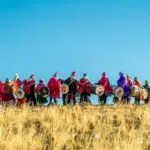The Longest Day (Summer Solstice) is observed on either June 20, 21, or 22, but this year, it falls on June 21. The timing shifts because it depends on when the Sun reaches its northernmost point from the celestial equator.It signals the start of astronomical summer. As a result, the days get shorter as summer progresses, first gradually but then at increasingly larger daily intervals as the September equinox approaches and ushers in the beginning of fall. Because the Sun travels across the sky in its most elongated path during the summer solstice, that day has the most daylight hours.
History of Longest Day (Summer Solstice)
The day of the summer solstice, which occurs when the Sun is at its farthest distant point from the equator, is also the day that is considered to be the longest of the year. Since the Neolithic era, this day has been observed as the summer solstice, also known as the summer’s midpoint. In the Neolithic cultures of Northern and Central Europe, the dates of the crop cycles were associated with the summer solstice. People in Celtic, Slavic, and Germanic cultures traditionally celebrated it by lighting bonfires to bolster the Sun’s vigor for the duration of the crop season and ensure a healthy harvest.Numerous Neolithic stone circles appear to have been constructed around the Sun’s movement at solstices. However, because there are no written accounts from this time period, determining the exact purpose of these rock edifices is difficult. On the other hand, the stones appear to be carefully positioned to align with the Sun’s movements, framing solar motion on the summer and winter solstices.Stones at specific solstice axes were even hammerstones to frame the sunrise for those standing in the center of the circle. This suggests that the alignment of the stones with the Sun’s motions was intentional. The summer solstice was regarded as a significant cultural event in many ancient communities, and it is still regarded as such by some modern groups.
Longest Day (Summer Solstice) timeline
There is a belief that the distinctive stone circle at Stonehenge determines the precise time of the summer solstice in June.
Ancient Egyptians develop the "shadow clock" — a portable gadget that monitors time throughout the day.
According to Pliny, a Roman author, naturalist, and natural philosopher, the first record of a sundial being in Rome dates back to 293 B.C.
The pocket sundial, the forerunner of the pocket watch, becomes very popular during this period.
Longest Day (Summer Solstice) FAQs
In what ways is the Summer Solstice linked to our mood?
The Summer Solstice marks the official start of summer in many parts of the world, which could positively impact health in the form of greater sleep and a happier disposition. People often feel better and are happier during this time of year.
What is the spiritual significance of summer?
The Summer Solstice serves as a bittersweet reminder that nothing lasts forever. We inhabit a realm where everything undergoes a continual cycle of rebirth and decay. When we keep in mind that the things we cherish don’t remain forever, we can cherish them much more while still physically present.
The solstice is observed by which religion?
Today, the solstices are almost exclusively celebrated by Pagans. Litha, the most major Pagan celebration, begins on the eve of the Summer Solstice and celebrates the power of the Sun God and the midsummer solstice.
How to Observe Longest Day (Summer Solstice)
-
Enjoy the outdoors
Eat outside and enjoy the beauty of the world around you. An outdoor gathering might be joyous, but a change of location can be just as enjoyable. Get the family together and visit a park or the beach for a barbecue or a picnic.
-
Look at the stars
You can stay up and gaze at the stars. If this is your first time, you can borrow a book or download an app to assist you in spotting the constellations.
-
Create a bucket list for the summer
Create a summer bucket list with your loved ones. Is there anything else you'd like to see on the list? Let your imagination run wild with a poster board and markers.
5 Interesting Facts About Solstice
-
Origin of the name
The word ‘solstice’ originates from the Latin words ‘sol,’ which means ‘Sun,’ and ‘stitium,’ which means ‘standing.’
-
Winter and Summer Solstice
As there is the Summer Solstice, there is also a Winter Solstice, which occurs twice a year and is also known as the Longest Night.
-
Tropic of Cancer and Capricorn
In the Northern Hemisphere, the Summer Solstice occurs when the Sun is directly overhead the Tropic of Cancer, whereas in the Southern Hemisphere, the Winter Solstice occurs when the Sun is directly above the Tropic of Capricorn.
-
Curved path
During the Summer Solstice, the Sun's route across the sky is curved, not a straight line.
-
Sunrise and sunset hours are the same
Although Summer Solstice is the day with the most daylight hours, it does not have the latest sunset or the earliest sunrise.
Why Longest Day (Summer Solstice) is Important
-
It has significant cultural meaning
Ancient societies and some current ones held the solstice as a significant cultural occasion, and it is still an occasion that is celebrated today. Why not take the day to celebrate an ancient historical occasion?
-
It is the longest day of the year
Who doesn’t love a long day? Today is the longest day, and you get to soak up more sun while enjoying the day with family and friends.
-
It signals the beginning of longer nights
This day marks the beginning of astronomical summer and the moment at which days begin to shorten and nights begin to lengthen. Longer nights equal more sleep, and who doesn’t love to feel well-rested.
Longest Day (Summer Solstice) dates
| Year | Date | Day |
|---|---|---|
| 2022 | June 21 | Tuesday |
| 2023 | June 21 | Wednesday |
| 2024 | June 21 | Friday |
| 2025 | June 20 | Friday |
| 2026 | June 21 | Sunday |
































